4. Subtropical Vegetation
A. Sub-tropical Broad-leaved Hill Forests:
- Distribution: These forests occur on the lower slopes of the Himalaya in Bengal and Assam and on other hill ranges such as Khasi, Nilgiri, Mahabaleshwar, Pachmarhi, Amarkantak and Parasnath.
- Important Species: In the eastern Himalayas, Oak, Chestnut, Ash, Birch, Pine are common species.
B. Sub-tropical Pine Forest
- Distribution: Subtropical chir pine forest occurs throughout the central and western Himalaya, and Khasi pine forest occurs in Khasi hills.
- Important Species: In the western Himalayas Chir Pine is the most important tree while Oak occurs in the wetter areas. In drier areas of Kashmir (rainfall 50-100cm) wild Olives are common with varieties of scrub.
- Chief Characteristics:
- These forests are almost pure throughout their zone of distribution.
- The understorey is also not pronounced.
C. Sub-tropical Dry Evergreen Forest
- Distribution: These forests occur in areas with low rainfall and consist of xerophytic, thorny and small-leaved evergreen species. Such forests are localised in the north-west corner of the country.
5. Temperate Vegetation
A. Himalayan Dry Temperate Vegetation
- Distribution: It is found in the inner dry ranges of the western Himalayas.
- Characteristic Features: It is predominantly a coniferous forest with xerophytic scrubs. Epiphytes and climbers are rare. [Coniferous trees are tall, straight with narrow needle like leaves. Most of the coniferous trees are evergreen but some like Larch are deciduous in nature]
- Important Species are Chilgoza, Deodar, Oak, Maple, Ash, Olive etc.
B. Himalayan Moist Temperate Vegetation
- Distribution: In the western Himalayas between 1500m and 3000m.
- Characteristic Features: The trees are 30 to 50m tall and undergrowth is mostly evergreen. Mosses and ferns grow freely on trees.
- Important Species: Deodar, Spruce, Maple, Walnut, Poplar, Cedar, Chestnut, Birch, Oak etc.
C. Montane Wet Temperate Vegetation
- Distribution: In the eastern Himalayas, evergreen wet temperate forests occur between 1800m and 2700m of altitude. Nilgiris, the Annamalai and the Palni hills of south India also have this kind of forests above 1500m of altitude. The trees there are shorter, and the undergrowth is denser with abundance of epiphytes, mosses and ferns.
- Characteristic Features: Rainfall is high, temperature is moderate in summer, and winter is cold. Rate of evaporation is not high. So trees do not shed their leaves annually, at least not at the same time.
- Important Species: Oak, Poplar, Elm, Laurel, Maple, Birch, Alder, Magnolia
6. Sub-Alpine and Alpine Vegetation
- Distribution: It occurs above 2700m of altitude in the eastern Himalayas and above 3000m in the western Himalayas.
- Important Species: It is a dense scrubby forest of Silver Fur, Juniper, Pine, Birch and Rhododendron.
- Characteristic Features:
- The alpine forests give way to alpine grasslands through shrubs and scrub. These extend upwards up to the snowline.
- Bugyals: Bugyals are high altitude alpine grasslands or meadows in Uttaranchal (at an elevation between 3400m and 4000m). These are referred to as ‘nature’s own gardens’. The topography of the terrain is either flat or sloped. The surface of these bugyals is covered with natural green grass and seasonal flowers. They are used by tribal herdsmen to graze their cattle. During the winter season the alpine meadows remain snow-covered. During summer months, the Bugyals present a riot of beautiful flowers and grass. Bugyals have a very fragile ecosystem. Some examples of Bugyals:
- Auli (near Joshimath) – A premier skii range is located here.
- Gorso
- Kwanri Bugyal
- Bedni
- Panwali and Kush Kalyan
- Dayara
- Munsiyari Bugyal
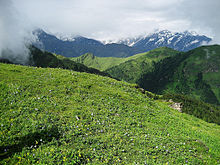 Auli Bugyal during summers
Auli Bugyal during summers
Auli Bugyal during winters
7. Littoral and Swamp Vegetation ( Mangrove Vegetation/ Tidal Forests)
- Distribution: In the tidal deltas of Ganga, Mahanadi, Godavari and Krishna rivers, evergreen mangrove vegetation thrives. These areas have rainfall of more than 200cm.
- Important Tree Species: Sundari, Agar, Bhendi, Keora, Nipa
- Important Animal Species: Turtles, crocodiles, gharials and snakes are the common animals found in these forests. Royal Bengal Tiger is found in the tidal forests of Ganga delta.
- Characteristic Features:
- The trees are mainly evergreen. Typically they produce tangled webs of arching roots that are exposed during low tides.
- This vegetation is an adaptation to two conditions:
- High water salinity
- Flooded at regular intervals
- Prominent among these adaptations are the presence of stilt roots, buttress, pneumatophores etc.
- Stilt roots (also called prop roots)- Stilt roots outgrow the trunk of the mangrove, branches or already existing stilt roots. As soon as stilt roots reach the ground the tip of the stilt root develops an underground root system with which it connects the stilt root into the ground and then develops one or more further stilt roots which grow arcuately into the air to again run into the ground to develop an underground root system, this process repeats several times.
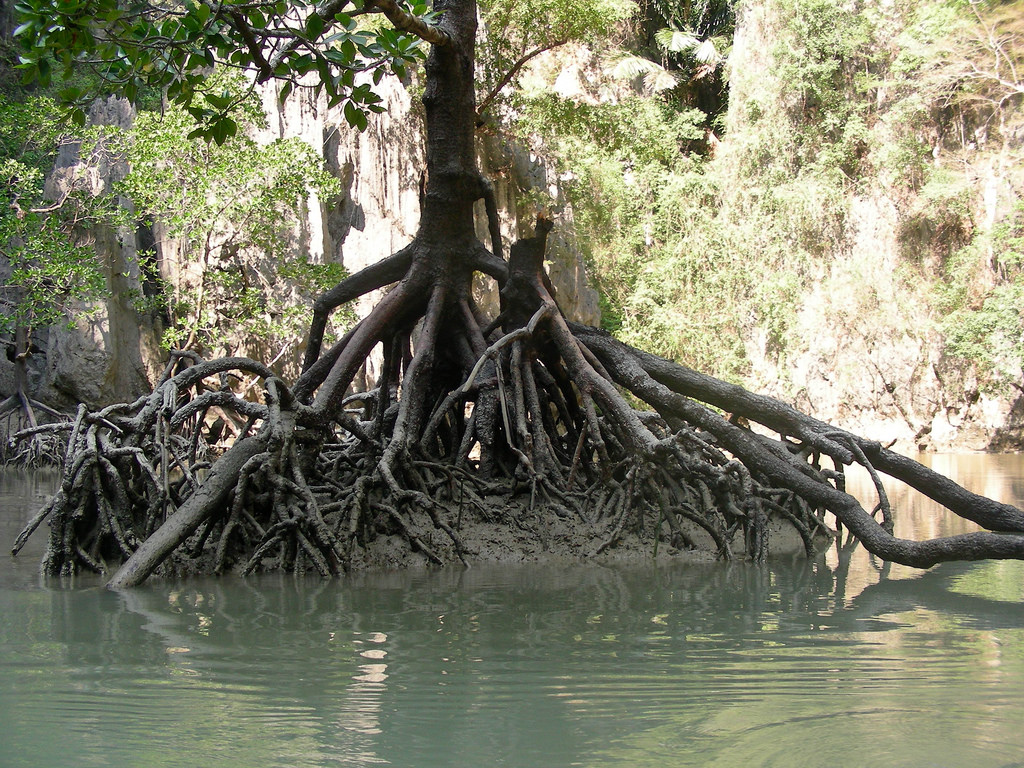
Source
- Buttress Roots – Buttress roots, developed by many trees concerning mangroves, provide stability to huge trees. The buttress roots can grow up to 10 meters in height. Buttress roots, also called buttresses do not continue their growth underground as they do above, underground buttresses develop a huge amount of small roots that grow in the soil under the buttress root.
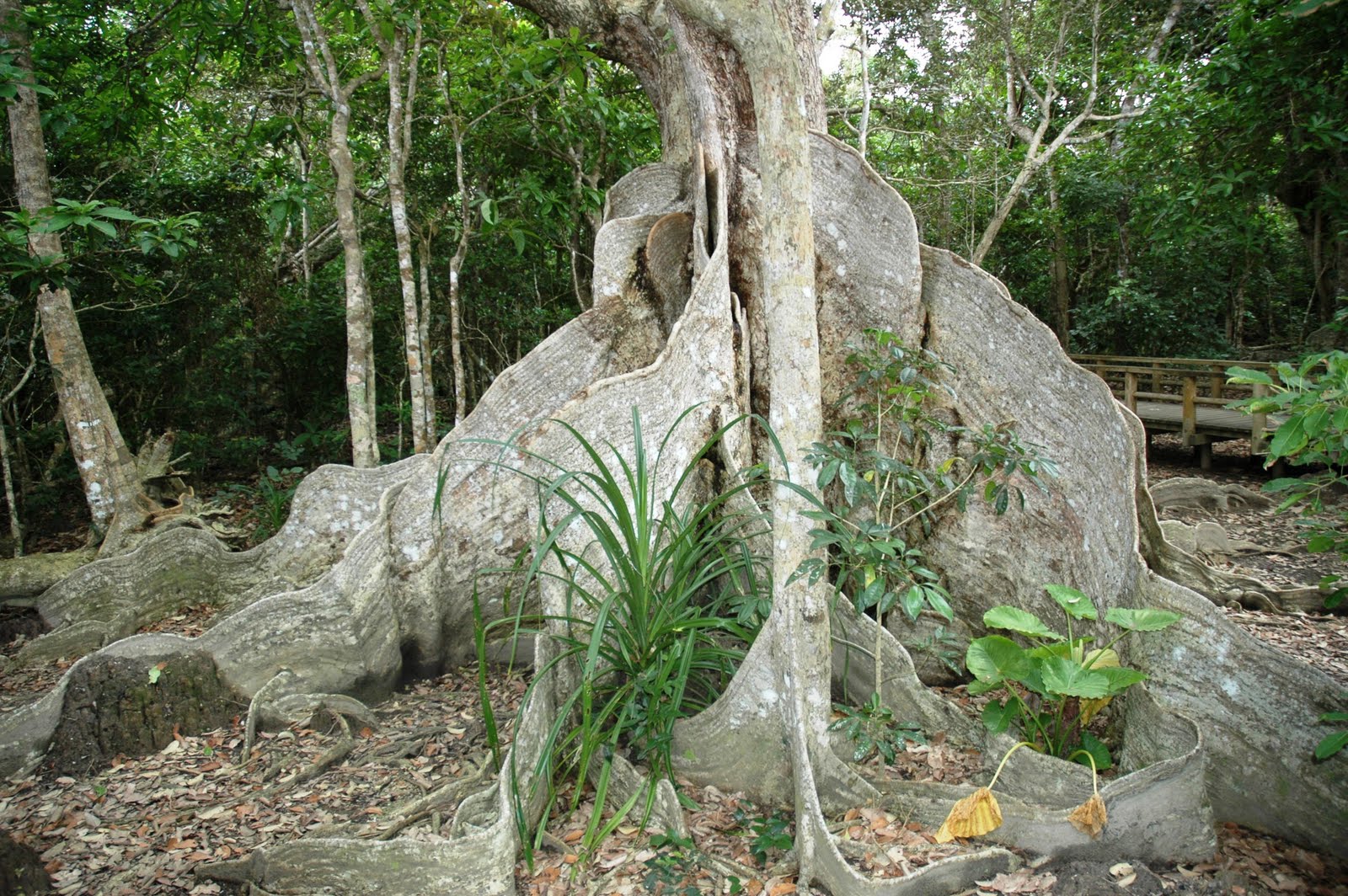
Source
- Pneumatophores – Because of waterlogged conditions, the roots are deprived of oxygen during high tides. Some mangrove roots extend vertically above the ground. These specialised roots are known as pneumatophores. These have pores which enable the trees to breathe when other roots are submerged under water during high tide.
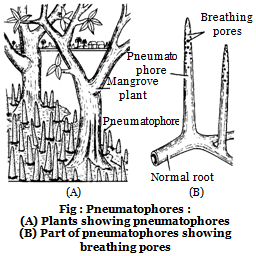
Source
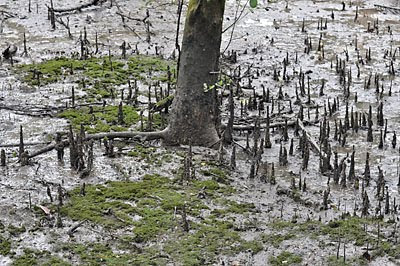
Sunderbans breathing roots
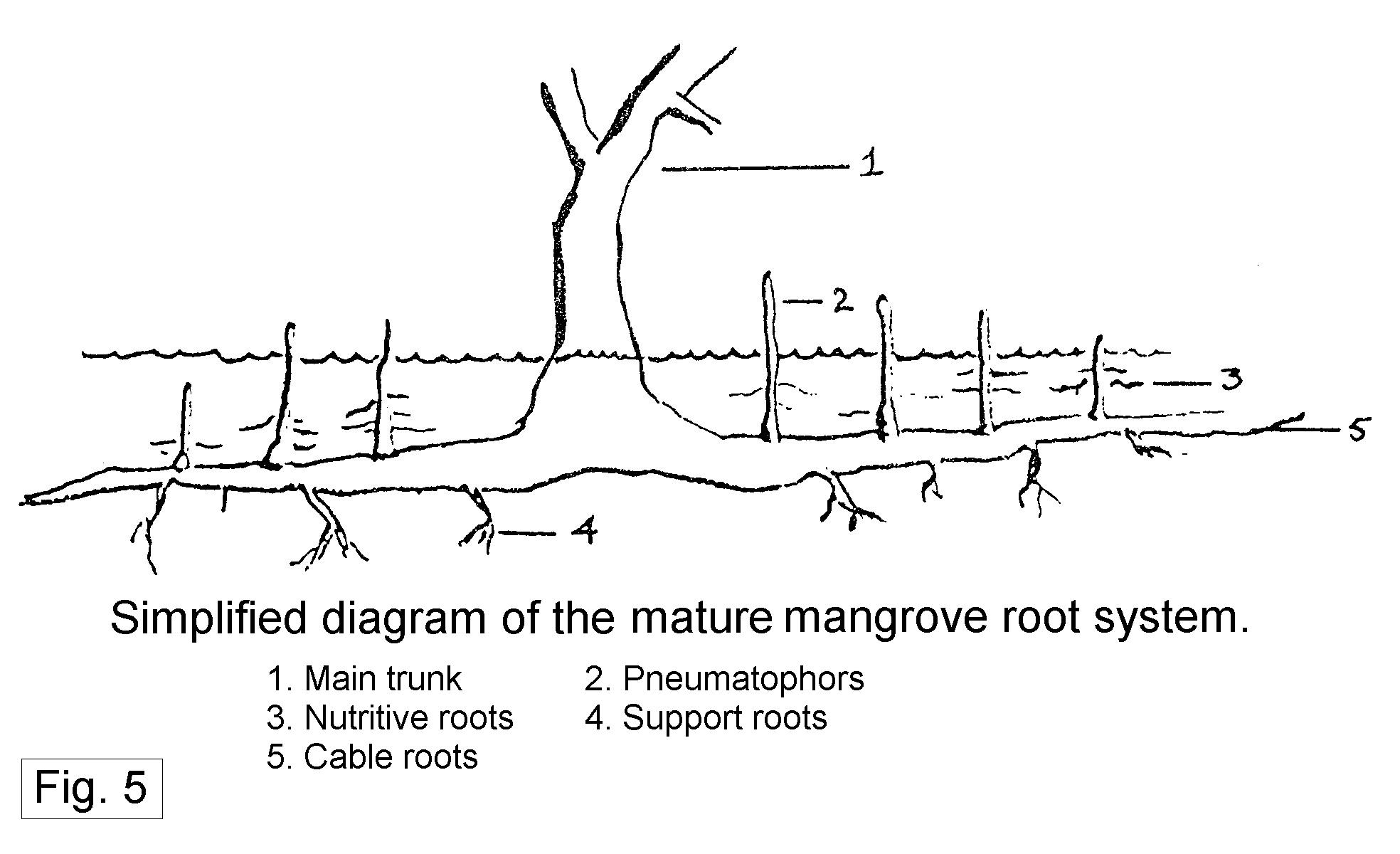
Source
- Stilt roots (also called prop roots)- Stilt roots outgrow the trunk of the mangrove, branches or already existing stilt roots. As soon as stilt roots reach the ground the tip of the stilt root develops an underground root system with which it connects the stilt root into the ground and then develops one or more further stilt roots which grow arcuately into the air to again run into the ground to develop an underground root system, this process repeats several times.
- Mangrove shrubs, known best for a thriving aquatic life nurtured within their mesh of stilt-roots also serve a vital socio-economic function. They act as “green shields” buffering the coastline against sea erosion, and the potentially devastating impacts of cyclones and tsunami.
- Mangroves support livelihood, essentially aquaculture, they supply medicinal plants, and fuel wood and construction materials. And in terms of ecological services, they stabilise shorelines, are nurseries for fishbreeding and filter heavy metals.
Note:
A study in November 2014 found mangrove patches in Karnataka. The Forest Survey of India missed recording these mangrove patches earlier as they were not large. According to the study, Karnataka has 300 hectares of mangrove forests spread over 3 coastal districts and a vibrant saline water ecosystem generally associated with India’s east coast. At the confluence of 4 rivers – Aghanashini, Gangavali, Sharavati and Venkatpura; and the Arabian Sea, is a long stretch of dense and tall mangrove vegetation locally known as Kandla or Sundar (Sundar is a well-known species of trees in mangrove forests after which the Sunderbans have been named). The study notes that while mangroves have been declining in several parts of the world from timber harvesting and pollution, these forests in Karnataka have in fact grown spatially over the last two decades.
Grasslands in India:
Owing to a short monsoon season followed by a long hot dry season, grasslands equivalent to Steppe/Pampas/Savanna are absent in India. The closed deciduous forest grades into thorny forest without an intermediate park like stage, and there is no steppe type of Grassland between the woodland and the desert.
But locally available types of grassland are:
- Hilly/Upland Grassland:
- Himalayas (generally above 1000m height)
- Deccan Plateau Hills (Western Ghats in Karnataka where forests have been cleared)
- Nilgiris have extensive grassy slopes (grass is often found interspersed with small isolated ‘shola’ forests*).
- Low Lands: in the plains of Punjab, Haryana, UP, Assam and Bihar.
- Riverine Grasses: These are found along the banks of the rivers which provide grazing facilities to cattle especially the bhabar pastures in northern India.
*‘Sholas’ are the mixed dense forests of tropical evergreen and temperate evergreen rainforest species in the Nilgiri Hills. The patches of shola forests are found mainly in valleys and are usually separated from one another by undulating montane grassland. The shola and grassland together form the shola-grassland complex or mosaic.
Now that we are done with the vegetation types of India, expand the following image for a quick revision!
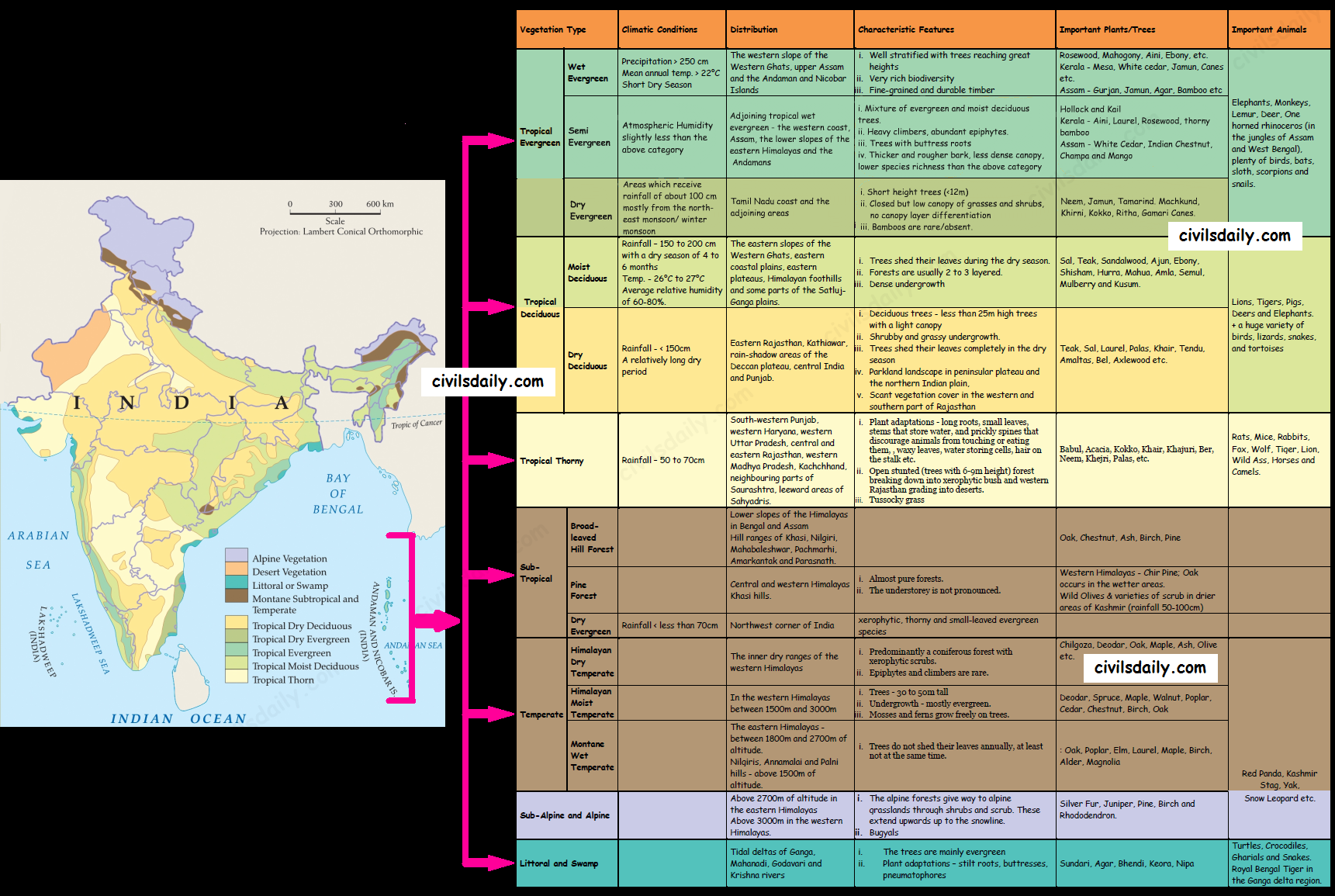
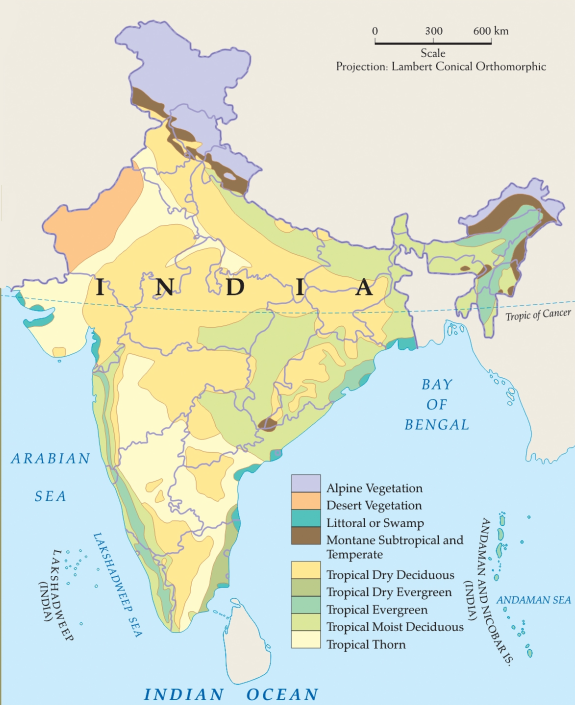
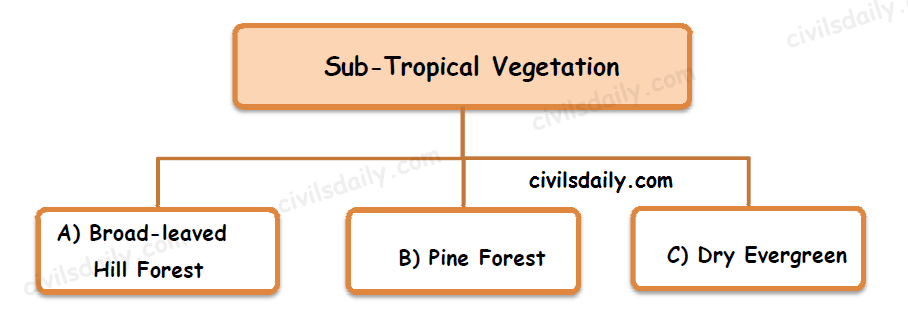

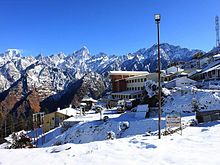
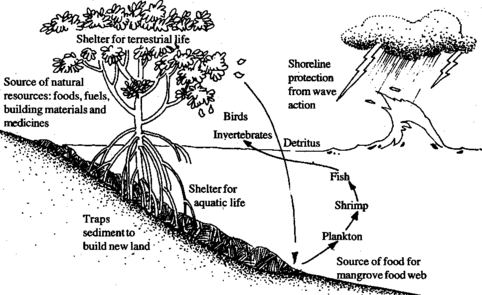


Thanks for the great posting and information provided by the Civilsdaily people.
You can be just said as the saviour for the students.
I wanna know some more information about the vegetation & Grasslands of India, as India being such a beautiful country to travel & enjoy all the Luxuries with the Help of Tibro